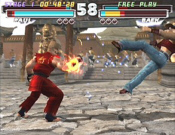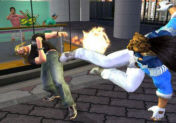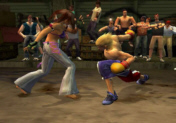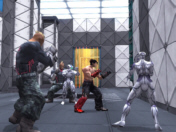Special: With the release of Tekken: Dark Resurrection on PSP, we take a look back at Namco's tweleve year old series that became the best fighting franchise of all time.
Tekken the fight to PlayStation 2
Tekken Tag Tournament was the fourth game in the series to make its way to the arcade in 1999, but it took a time out from telling its story and is therefore not considered canon. Instead, the characters from all three previous games compete in what is described as a УDream Match Iron Fist Tournament.Ф

Besides having a total of 38 fighters to choose from, players formed a tag team by selecting two characters instead of just one. This meant that for the first time in Tekken history, the game wasn't a one-on-one fighting experience. Being able to swap fighters during matches changed the strategy a lot. Suddenly, players could go from near death to gaining a second wind by calling on their teammate with the 5 button. Further altering the original gameplay, which hadn't really changed from the first Tekken, was the fact that when a fighter was in reserve, he or she would recover a little bit of health.
PlayStation 2 launched in October of 2000 and to the delight of many Tekken fans, Namco was there to support the system from day one by porting Tekken Tag Tournament to the new console. At the time, the biggest competition that Namco faced on another system was actually its very own smash-hit Soul Calibur, a weapons-based fighter which it released for Sega Dreamcast also on its launch date a year earlier. In hindsight, Soul Calibur was the more popular of the two games since the latest Tekken wasn't a landmark beginning, but a continuation of a game series we've become accustomed to. This didn't stop fans from reveling in the PS2-exclusive enhancements over the arcade version. A number of improvements were made to the graphics to make it look better than the Namco System 12 machine. Also, because the machine had only two joysticks, PS2 owners could two-up the arcade by using the system's underrated multi-tap for unique four-player battles.

The tag system was unfortunately axed in Tekken 4, which appeared in the arcade in 2001. But, that didn't mean that this game went back to its roots entirely. For the first time, enclosed environments replaced the never-ending flat surfaces and the never-accessible backgrounds of previous games. There were city streets containing tall buildings, a small pond with some shoreline, and an underground fight club complete with spectators among the new areas. Each had interactive elements that changed the face of the fight. The pond was set on an incline, so the player sinking further into the water gave the advantage to the person closer to the land. Likewise, being backed up against a city wall or railing left players open to lengthy combos.
To counter being trapped into taking the lower ground or being abused against a wall, a position switch button was added. This evade move caused one of the players to grab the other and exchange positions. While the mechanic worked to thwart the unfairness of being stuck up against an impassable boundary, many gamers were still turned off by the closed and uneven arenas. It couldn't be denied, though, that the game looked better than it did a generation ago on Namco System 12 and the original PlayStation. Even Tekken Tag Tournament couldn't compare, as it was basically an upgrade of Tekken 3.

When Tekken 4 went from Namco System 246 to PlayStation 2 in 2002, it was one of the first games to support Progressive Scan. As impressive as the arcade game looked, it was even prettier when paired with an HDTV if you happened to have one at that time. Tekken Force, one of the unlockable PS2-exclusive modes in Tekken 3, was available from the get-go here. Although it only spanned four levels again, the action was slightly more refined and filled some of plot holes that the series had developed.
The character roster size was smaller than in Tekken Tag Tournament, but that's because this game had a storyline and had to account for fighters that didn't fit into the plot. Jin Kazama lured and fought against The Ogre in the final stage of Tekken 3, as his grandfather Heihachi Mishima had anticipated. When The Ogre morphed into a more hideous form known as True Ogre and Jin still beat it, Heihachi's plan to capture the god was ruined. So, in his mind, he did what any evil grandfather would do and gunned down his own grandson. But, since Jin had inherited the Devil Gene from his father, he grew wings and flew away, which is where the story picks up in Tekken 4.
Heihachi wasn't able to capture The Ogre and utilize his power, yet he still attempted to make good of the scraps left behind from when Jin destroyed the being. The conclusion his researchers came to was that The Ogre's blood samples, skin tissue, and hoof fragments needed to be combined with The Devil Gene to create another organism containing Ogre's immense power. After unsuccessfully searching for Jin, Heihachi sent his Tekken Force team to the lab of a leading-edge biotech firm, The G Corporation. Here, the body of his son late son, Kazuya, was supposed being stored. While he watched from a remote location, Heihachi soon found out that his son wasn't dead after all, as Kazuya killed every member of the Tekken Force team in seconds. In an effort to lure both his son and grandson, Heihachi announced the King of the Iron Fist Tournament 4 and put his Mishima Financial Empire up as the prize.

The conclusion of Tekken 4 was gripping. It featured not one, but two father-son battles. First, Jin battles his dad, Kazuya, and wins the match. Then, he moves onto his grandfather, Heihachi. Jin wins again and flies away again by using his Devil-donned wings similar to the Tekken 3 ending. All of a sudden, helicopters carrying dozens of Jack-4 robots raid the island where the fight was located. Left unconscious, both Heihachi and Kazuya are forced to battle the Jacks side by side. The few seconds in which they put their rivalry aside ends when Kazuya throws his father into a group of Jacks. They hold Heihachi down as one of the Jacks reveals a self-destruct timer in his robot head. Kazuya escapes to safety, but the island is blown up in dramatic fashion. In the distance, a shadowy figure radios the news to an unknown recipient saying, УHeihachi is dead.Ф
As one Mishima Уdied,Ф however, another rose from captivity. Apparently, the father of Heichachi, Jinpachi Mishima, was being held prisoner ever since his son hostilely took over Mishima Zaibatsu. It is hard to believe that Heichachi, now in his 70s, has a father that's able to walk, never mind fight, making the four generations of Mishima a videogame version of the Mandelbaum family. Being freed from 50 years of imprisonment, Jinapchi takes over the business that he founded and announces the fifth King of the Iron Fist Tournament.

Tekken 5 marked the 10th Anniversary of Tekken when it released in 2004 on the Namco System 258 arcade machine and in 2005 on PlayStation 2. In that time, the series looked as if it had progressed substantially when side by side with the first game. On PS2, it was quite simple to actually compare this game with its PlayStation predecessors because Tekken, Tekken 2 and Tekken 3 were available right away in the Tekken History mode. These arcade-perfect ports were a great way to relive the days in which you'd enter a gallery with your pockets full of quarters and exit penniless.
Going back through the first three games demonstrated that while the series' look has changed drastically, its gameplay mechanics have gone untouched. In fact, Tekken 5 played more like the PlayStation trio than Tekken 4. This was mostly because Namco decided to open up the arenas a little more instead of sticking with closed environments and uneven level designs. There were still boundaries in which players could get trapped against and floors that produced cracks if a fighter's body was smacked against the ground. However, players were less likely to get stuck this time around and the interactive cracks in the ground were more graphical touches than anything.

In addition to reversing the enclosed environment designs of the last game, Tekken 5 sped up the gameplay so that it was slightly faster than Tekken 4. It was really amazing to see the smoothest character models yet punch and kick at a blazing rate with no slowdown. Their stunning appearance is due in part to the vastly improved textures and lighting effects, most evident for showing off the properly toned bodies of the more muscular characters. Square muscles that looked like as if some fighters had steroid side-effects were finally a thing of the past in this game.
The roster included 27 returning characters, 3 new characters and the same number of successors or alternate characters. The new fighters were Raven, Feng Wei, and Asuka Kazama. As the last name implies, Asuka is Jin's cousin and she fights a lot like his mother from Tekken 2. In a surprise move, the main boss of the game, Jinpachi Mishma, was not playable for the first time in the series' history. However, hackers quickly put an end to that Tekken using a Gameshark or similar cheating device to unlock him as a fighter.
The rest of the characters in this game saw user-chosen outfit and accessory changes thanks to a load of customization options. In the arcade, a Tekken 5 Data Card could be used to save these custom creations as well as the leftover virtual cash used to buy the add-ons. Alas, it cost real money to purchase one of these data cards. But on the bright side, you could always use the change to play more Tekken 5.

The use of a data card to save a customized character was a unique extra for the arcade. But as always, the console-exclusive features outshined anything seen in the gallery. Besides the incredible Tekken History mode, there were the typical versus and survival modes and a fun-filled theatre section. Tekken Force didn't return to Tekken 5, but a set of action stages akin to the mini-mode acted as a worthy replacement. Dubbed УDevil Within,Ф this side story had players fight as Jin in order to unlock Mishma family secrets. There was still no new Tekken Ball, but the history mode was enough to keep most players entertained when they needed a break from getting their butt kicked.
In 2005, the arcade version of did improve in a full update on the same machine and became known as Tekken 5: Dark Resurrection. Notable changes included two brand new characters, the costumes added to the PS2 version and additional arenas. In July of 2006, this arcade update was converted to handheld form for Sony's PSP.
Tekken it to the Streets
Between Tekken Tag Tournament and Tekken 4, two portable versions of the series were released; one on Bandai's WonderSwan in 1999 and the other on Nintendo's Game Boy Advance in 2002. Because WonderSwan never made it beyond Japan, stateside gamers didn't get an opportunity to try Tekken Card Challenge. Even so, the mechanics of this monochrome game were similar to others on the market like Pokщmon Trading Card Game on Game Boy Color. Using a character from the series, players battled a cast of rivals using cards to attack their opponent, and if played right, got to open up their storyline in the main adventure mode. It should be noted, though, that the story here is not considered canon and therefore doesn't have any effect on Mishima saga.
The same applied to the events of the Game Boy Advance game a year later, Tekken Advance. Considering the handheld had fewer buttons than previous systems, Namco had to make several adjustments. The A button handled all of the kicks, the B button executed every punch and the R button performed one of the character's grappling moves. The graphics were also reworked. While this meant that the visuals were more flat, the sprites still stood out and the sidestepping remained in the game so that it retained its 3D feel.

The result was a simplified, yet solid 2D fighter. In fact, Tekken Advance was the best fighting game in its genre for the GBA. This is because it actually felt like a Tekken game. Sure, there were a mere 11 characters on the entire cartridge, but all of the favorites were there: Jin, Gun Jack, King, Nina, Yoshimitsu, Forrest Law, Hwoarang, Paul, Ling Xiaoyu and a hidden Heihachi. And, all of the essential modes of Arcade, Vs. Battle, Time Attack, Survival, Tag Battle, Vs. Tag Battle and Practice made the cut. The Tag modes were surprisingly like Tekken Tag Tournament, but with 3-versus-3 teams. It was even better when competing head-to-head with a buddy via an old link cable.
The latest Tekken game to enter the dojo is actually a portable title, too. Tekken: Dark Resurrection for PSP is technically an update of an update. Released in July of 2006, it featured all of the arcade's version 5.2 updates. Added to the PSP were extras modes: Tekken Dojo to beat the ghost versions of other players; Tekken Bowl, which was not quite Tekken Ball, but close; and Game-Sharing multiplayer so that only one PSP owner needs a copy to battle other close by system owners.


From here, the Tekken series is set for King of the Iron Fist Tournament 6, as promised in the E3 2005 trailer for Tekken 6. While it'll some time before the game makes its way to the arcade and then onto PS3, there's already twelve years of Tekken to keep us occupied until that day arrives.